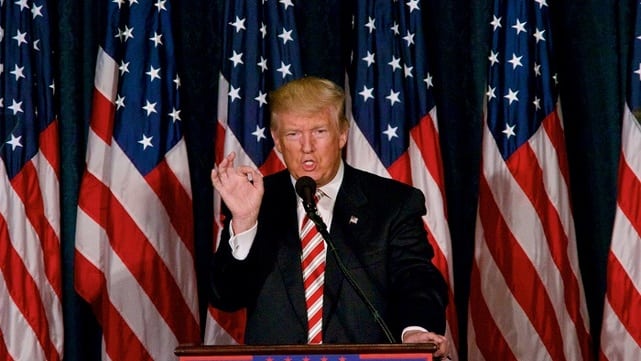If one is to believe Michael Wolff’s titillating tell-all Fire and Fury, the Trump administration is a house divided against itself with traditional Republicans to the right, the Jarvanka (Jared and Ivanka) loyalists to the left and the new breed of White House MAGA’ers somewhere betwixt.
Yet somehow America’s most polarising president was able to receive enough Republican support to pass his largest piece of legislation so far, a sweeping overhaul of the US tax code.
This achievement is especially remarkable when you consider Trump’s tax plan will add approximately $1trn to the national debt, according to the joint committee on taxation, a group of nonpartisan tax experts. A hardly surprising revelation from the self-proclaimed king of debt.
For the fiscal year 2018, experts estimate the latest commander in chief will rack up a $440bn deficit, a historically high figure, especially considering markets across the world are booming.
There’s nothing that has gotten the Republican party frothing at the mouth in recent years quite like the prospect of adding to the national debt, which was 106.71% of GDP in 2016, at least when a Democrat has been in charge of the country. I guess the fact the wealthiest Americans are set to become the biggest beneficiaries from the new tax bill helps ease the pain.
Investors have also been largely supportive of number 45’s measures, claiming it will boost American growth. The acceleration of the growth rate is up for debate. Trump’s team is claiming a 3 to 5% boost to GDP, while most economists predict a more modest rise of 0.8%.
Numerous American and international blue-chip companies have also shown early support for the bill, which sees the level of corporate tax fall from 35% to 20%.
One question that received some attention last week but has been effectively pushed to the side is how the US is supposed to pay for this?
Last week, reports surfaced that China was contemplating paring back its purchases of US treasuries or ditching its debt pile completely.
The news pushed global bond yields higher and US 10-year treasury yields to their highest level in 10 months.
Scaling back
The Chinese government has since denied it is considering cutting or halting its purchases of US treasuries. However, the reality is that China and Japan have already been scaling back their purchases of American debt.
Data from the US Treasury Department on Wednesday revealed that China and Japan, America’s two biggest foreign creditors, had reduced their debt holdings last November.
China decreased its stock pile of Treasuries from $1.189trn in October 2017 to $1.176trn the following month. Japan, similarly reduced its holdings by some $10bn, taking its holdings from $1.094trn to $1.084trn over the period.
In total, foreign institutions sold $6.4bn worth of Treasuries in November. But this trend has persisted for some time now, with governments scaling back their dollar exposure almost every month since 2014.
With president Trump about to increase the Federal deficit to levels that some warn are unsustainable, this could prove disastrous for the bond market. And higher creeping yields could spell trouble for equity markets too.
Although it is still early days, BlackRock’s global chief investment strategist Richard Turnill predicts Trump’s tax plan will result in “higher treasury yields and steeper yield curves”.
“The overhaul of the US tax code includes supply-side reforms and injects significant near-term demand stimulus into a US economy running at near-full employment,” he says. “A faster-growing US may accelerate global growth, and result in rising inflation, higher treasury yields and steeper yield curves.”
Who will buy?
But what if president Xi Jingping decides to pull the plug and America loses its biggest bond buyer? What then?
Well, the next biggest foreign holders of US government bonds, according to the Treasury Department’s capital flows data, are Ireland and the Cayman Islands, which collectively owned $598.1bn in November.
That’s just a little over half the amount of US debt that China owns currently. So, if both China and Japan were to cut their purchases by half, that would be some $1.130trn worth of debt left unaccounted for.
But what kind of impact has China’s treasury purchases had on yields over time? That is precisely the question the Federal Reserve tried to answer in a study it published in 2012, notes Ed Smith, Rathbones’ head of asset allocation research.
“That paper concluded that every $100bn of Chinese purchases had decreased the yield on the five-year treasury between 0.7% and 0.2%,” he recalls. “If we assume that it would work symmetrically in the opposite direction, that is not an insignificant effect of China continued to sell but its unlikely to cause a huge fall either.”
In any case, Smith thinks it is unlikely China will accelerate its sales of US treasuries, at least not at “an alarming rate.” Because China still holds a significant amount of dollar denominated assets, ditching its treasury stock pile too quickly would not be in its best interest, he argues.
The Chinese government “does want to move away from an official reserve account disproportionately weighted toward dollar assets. We know its currency is now pegged to a basket of reserve currencies rather than just the dollar, but it is probably not in their interest to do so at an alarming rate, given how much they currently hold and given their other bonds and outstanding debt obligations in the state owned and private sectors are denominated in dollars and priced off dollar rates,” Smith says.
“Also, China does need to increase government spending as it looks to do some of the painful reforms and ease back on credit creation that it has been discussing in the last 18 months, it needs to offset that with a bit of welfare spending,” he adds.











